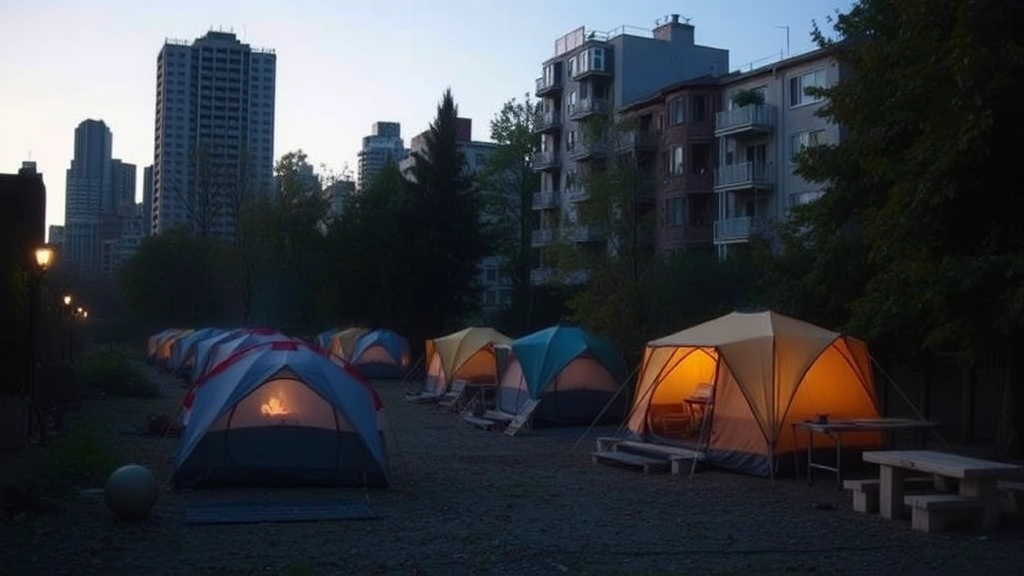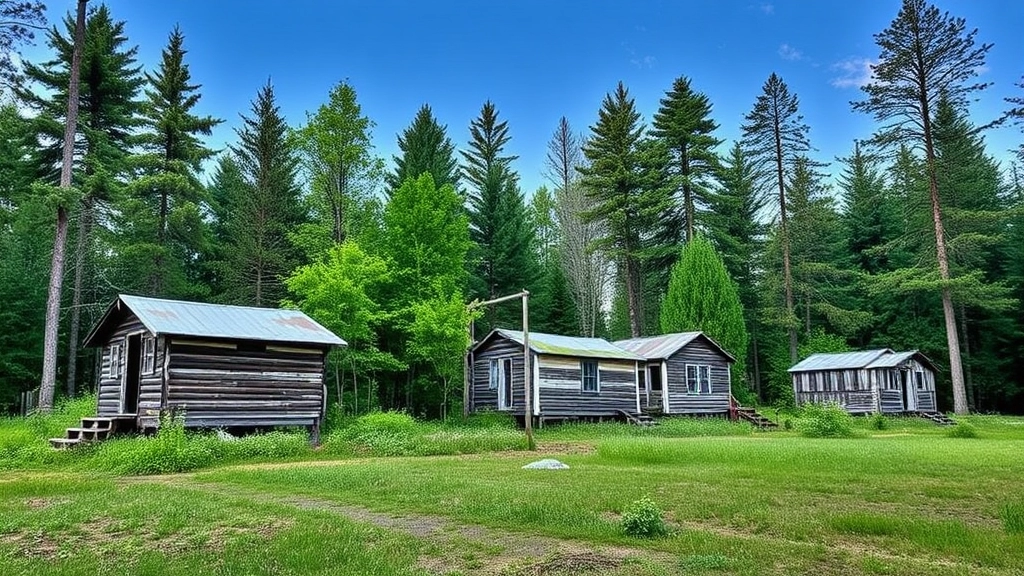Exploring Abandoned Summer Camps
Ever wondered what secrets lie within abandoned summer camps? These once lively havens of fun and adventure now stand as eerie monuments of a bygone era. From their rich history to the reasons behind their abandonment, this article dives deep into the world of these forgotten places. We’ll explore popular locations, the thrill of urban exploration, and the safety and legal considerations you must keep in mind. You’ll also discover the cultural impact, preservation efforts, and how these camps inspire photographers and artists alike.
In this journey, you’ll uncover the past and ponder the future of abandoned summer camps. Whether you’re a history buff, an urban explorer, or an art enthusiast, there’s something captivating about these decaying relics. We’ll share real-life stories, tips for safe exploration, and even discuss the potential for restoration. So, if you’ve ever been intrigued by the haunting beauty of abandoned summer camps, read on to satisfy your curiosity and perhaps find inspiration for your next adventure.
History of Abandoned Summer Camps
Ever wondered why so many charming summer camps are left to decay? It’s a question I’ve asked myself numerous times. These places, once bustling with laughter and activities, now stand eerily silent. But how did we get here?
The Golden Age of Summer Camps
Summer camps had their heyday in the mid-20th century. Picture this: kids running around, making friendships, and learning new skills. It was a time when parents sent their children off for weeks, trusting these camps to provide a wholesome experience. These camps sprouted up everywhere, from the lush forests of New England to the scenic lakes of the Midwest.
The Downward Spiral
But what changed? Why did these vibrant spots turn into ghostly relics? Let’s break it down:
- Economic Shifts: The economy took a hit, and maintaining these camps became financially unfeasible. Many couldn’t keep up with rising costs and dwindling enrolments.
- Changing Interests: Kids’ interests evolved. Video games, smartphones, and other tech distractions started competing with the allure of the great outdoors.
- Liability Issues: Legal concerns grew. The risk of accidents and the subsequent lawsuits made many camp owners rethink their business models.
- Environmental Factors: Natural disasters like floods, fires, and storms wreaked havoc on many camps, leading to their eventual abandonment.
Real-Life Examples
Take Camp Crystal Lake, for instance. No, not the one from the horror movies, but a real camp that faced economic hardship and was eventually deserted. Or Camp Kenwood in New Hampshire, which shut down due to declining enrolment and rising maintenance costs.
The Nostalgia Factor
There’s a certain nostalgia attached to these places. Many of us remember our camp days fondly. The ghost stories by the campfire, the canoe races, the arts and crafts sessions â all of it. It’s heartbreaking to see these once-thriving spots now covered in moss and graffiti. For those interested in the modern camp experience, check out these top sleepaway camps that continue to thrive today. Also, if you’re considering setting up a new camp, our ultimate guide to summer camp layout design could be invaluable.
Reasons for Abandonment

Ever wonder why so many summer camps end up abandoned?
It’s a question that pops up often, especially for those into urban exploration or just curious about these eerie spots.
Let’s dive into the reasons for abandonment.
Financial Struggles
First up, money.
Running a summer camp isn’t cheap.
Maintenance, staff salaries, insurance—these costs add up quickly.
If the camp isn’t pulling in enough campers, the finances can go south fast.
Changing Interests
Kids today aren’t as keen on traditional summer camps.
They’d rather spend time on their gadgets or go to specialised camps that focus on sports, arts, or tech.
This shift in interest leaves many general summer camps struggling to fill spots.
Natural Disasters
Mother Nature can be brutal.
Floods, wildfires, and storms can wreak havoc on campgrounds.
Sometimes, the damage is so extensive that rebuilding just isn’t worth it.
Legal Issues
Sometimes, it’s all about the red tape.
Zoning laws change, or there might be legal battles over the land.
When the legal fees pile up, owners might decide to cut their losses and abandon the camp.
Management Problems
Poor management can sink any business, and summer camps are no exception.
Bad decisions, lack of marketing, or just plain incompetence can lead to a camp’s downfall.
Safety Concerns
If a camp gains a reputation for being unsafe, it’s game over.
Parents won’t send their kids to a place with a history of accidents or poor conditions.
Stories and Examples
Take Camp Crystal Lake, for example.
Okay, maybe that’s a bit of a stretch (thanks, Jason).
But there are real-life examples like Camp Scott in Oklahoma, which closed after a tragic incident.
Or the many camps in California that shut down due to wildfire damage.
Internal Links
Want to know more about these spooky spots?
Check out our section on Popular Abandoned Camp Locations.
Curious about exploring these places yourself?
Head over to Urban Exploration of Camps for tips and tricks.
Popular Abandoned Camp Locations
Ever wondered where you can find some of the most intriguing abandoned summer camps? Trust me, you’re not alone. Whether you’re an urban explorer, a photographer, or just someone with a curiosity for the eerie and mysterious, knowing where to look is half the adventure. So, let’s dive into some of the most popular abandoned camp locations that you should definitely have on your radar.
1. Camp Crystal Lake, New Jersey
Alright, let’s kick things off with a name that might ring a bell for horror movie buffs. Camp Crystal Lake in New Jersey isn’t just a figment of Hollywood’s imagination. While the real camp isn’t as sinister as its fictional counterpart, it’s still an abandoned site that’s tinged with an eerie vibe. Perfect for those looking to relive some classic horror movie moments.
2. Camp Scott, Oklahoma
Next up, we’ve got Camp Scott in Oklahoma. This place is infamous for a tragic incident back in the 1970s, which led to its closure. The camp has been left untouched ever since, making it a hotspot for those who love a good ghost story. Walking through the deserted cabins and overgrown trails, you can almost feel the weight of its history.
3. Camp Comfort, California
California isn’t just about beaches and Hollywood. Camp Comfort in Ventura County is another abandoned gem. Once a bustling summer camp, it’s now a quiet, deserted area with dilapidated structures that nature is slowly reclaiming. The serenity of this place is oddly comforting, making it a unique spot for both urban explorers and photographers.
4. Camp Michaux, Pennsylvania
Camp Michaux in Pennsylvania has a rich history that dates back to the Revolutionary War. Initially a farm, it later became a secret POW camp during World War II, and eventually a summer camp. Now abandoned, it offers a fascinating blend of history and decay. The remnants of old barracks and mess halls make for some compelling exploration.
5. Camp Hero, New York
Let’s not forget about Camp Hero in Montauk, New York. Originally a military base, it later transformed into a summer camp before being abandoned. The place is shrouded in conspiracy theories and local legends, adding an extra layer of intrigue. If you’re into exploring places with a mysterious past, Camp Hero should be on your list.
Why These Locations?
You might be wondering, why these specific locations? Here’s the deal:
- Historical Significance: Each of these camps has a unique backstory that adds to the allure.
- Accessibility: While some are easier to get to than others, they all offer a relatively straightforward exploration experience.
- Visual Appeal: The decaying structures and overgrown landscapes provide a hauntingly beautiful setting, perfect for photography and art.
Tips for Exploring Abandoned Camps
If you’re planning to visit any of these locations, keep these tips in mind:
- Safety First: Always prioritize your safety. Wear appropriate gear and be cautious of unstable structures.
- Legalities: Make sure you’re not trespassing. Some of these sites might be on private property or have restricted access.
- Respect the Site: Leave no trace. These places are historical landmarks in their own right, so treat them with respect.
For more tips on how to make the most of your summer adventures, check out our top tips for summer tent camping and explore some fun activities at summer camp that can enhance your outdoor experience.
Urban Exploration of Camps

Ever wondered what it’s like to explore an abandoned summer camp?
Yeah, me too.
There’s something thrilling about stepping into a place frozen in time.
But before you grab your flashlight and head out, let’s dive into the nitty-gritty of urban exploration of camps.
Why Do People Explore Abandoned Camps?
First off, why even bother?
Well, here’s why:
- Nostalgia: Many of us have fond memories of summer camps. Exploring abandoned ones can bring back those memories.
- Adventure: It’s like stepping into a real-life horror movie. Minus the monsters, hopefully.
- Photography: These places make for some killer shots. The decay, the overgrowth, the forgotten relics – all perfect for your Instagram feed.
- Curiosity: What happened here? Why was it abandoned? The mystery is often too tempting to resist.
What to Expect When You’re Exploring
Alright, so you’re pumped and ready to go.
But what should you expect?
- Nature Taking Over: Trees growing through cabins, vines wrapping around swings, and animals making themselves at home.
- Decay: Buildings falling apart, rusted equipment, and broken windows.
- Eerie Silence: The lack of human activity can be both peaceful and unsettling.
Tips for a Safe Exploration
Safety first, folks.
Here’s what you need to know:
- Go in Groups: Never go alone. Always have a buddy or two.
- Gear Up: Wear sturdy shoes, bring a flashlight, and carry a first aid kit.
- Check the Weather: Avoid exploring in bad weather. Slippery surfaces and poor visibility are a no-go.
- Stay Legal: Trespassing is a big no-no. Always check if you need permission to explore the camp.
Legal Considerations
Let’s talk legal stuff.
- Trespassing Laws: Know them. Ignorance isn’t an excuse.
- Permission: Some camps might be on private property. Always seek permission if required.
- Local Regulations: Different areas have different rules. Do your homework.
Real Stories from Explorers
Want to hear a cool story?
A friend of mine, Jake, once explored an old camp in the woods.
He found an old diary in one of the cabins.
It belonged to a camper from the ’80s.
Reading those entries was like stepping back in time.
Final Thoughts
Urban exploration of abandoned camps is a mix of nostalgia, adventure, and mystery.
But always remember: safety and legality come first.
So, are you ready to explore?
Grab your gear, get your mates, and dive into the adventure.
Just remember to leave no trace and respect the history of these forgotten places.
Safety and Legal Considerations
Ever wondered if exploring abandoned summer camps is worth the risk? You’re not alone. Many urban explorers are drawn to these eerie, forgotten places, but safety and legal concerns are often top of mind. So, let’s break it down.
Why Safety Matters
First things first, abandoned camps can be dangerous. Think about it: these places have been left to the elements for years, if not decades. That means:
- Structural Instability: Buildings can collapse without warning.
- Hazardous Materials: Old camps might have asbestos, lead paint, or other harmful substances.
- Wildlife: Nature reclaims abandoned spaces quickly, and that includes animals you might not want to bump into.
- Hidden Dangers: Think open wells, rusty nails, and broken glass.
So, what’s the game plan? Here are some essential tips:
- Wear Protective Gear: Gloves, boots, and a hard hat can save you a trip to A&E.
- Bring a Buddy: Never explore alone. If something goes wrong, you’ll want someone there to help.
- Stay Alert: Keep your eyes and ears open for any signs of danger.
- First Aid Kit: Better safe than sorry. Always have one on hand.
Legal Concerns
Now, let’s talk legality. Trespassing is a big deal, and getting caught can lead to fines or even jail time. Here’s what you need to know:
- Know the Laws: Different places have different rules. Make sure you’re aware of local trespassing laws.
- Get Permission: If you can, always seek permission from the property owner. It’s not just polite; it’s the law.
- No Vandalism: Leave no trace. Damaging property is illegal and ruins the experience for others.
- Respect Signs: “No Trespassing” means just that. Don’t push your luck.
Real Stories
I’ve heard tales of explorers who stumbled upon hidden treasures, but also of those who ended up in sticky situations. One guy I know found an old camp that had been untouched for years. He took some amazing photos but also came across a bear. Luckily, he knew how to handle it and got out safely. Another friend wasn’t so luckyâhe ignored a “No Trespassing” sign and ended up with a hefty fine.
Cultural Impact and Stories

Ever wondered why abandoned summer camps fascinate us so much?
It’s not just the eerie vibes or the thrill of urban exploration.
There’s something deeper.
Something cultural.
These places are time capsules of our shared history.
Why Do We Care About Abandoned Camps?
First off, these camps were once buzzing with life.
Kids laughing, campfires crackling, and the smell of toasted marshmallows.
Now, they’re silent.
But that silence speaks volumes.
It tells stories of changing times, economic shifts, and sometimes, tragic events.
How Do They Impact Our Culture?
- Nostalgia: Many of us went to summer camps. Seeing them abandoned stirs up memories. It’s like a direct line to our childhood.
- Mystery and Exploration: These camps are magnets for urban explorers. They want to uncover what’s been left behind. Think of it as modern-day treasure hunting.
- Art and Media: Movies, books, and photography often use these camps as settings. They add an element of suspense and intrigue. Ever seen a horror movie set in an abandoned camp? Exactly.
Real Stories from Abandoned Camps
I remember visiting one in the UK.
The place was a ghost town.
Graffiti on the walls, nature reclaiming its territory, and old, rusted swings creaking in the wind.
I met a fellow explorer there.
He told me about the camp’s heyday.
Turns out, it was once a popular spot for school trips.
Now, it’s just a memory.
Why Should You Care?
- Cultural Significance: These camps are part of our collective memory.
- Creative Inspiration: They’re gold mines for artists and storytellers.
- Historical Value: They offer a glimpse into past lifestyles and societal changes.
So, What’s the Takeaway?
Abandoned summer camps aren’t just empty spaces.
They’re rich with stories and cultural significance.
Next time you come across one, remember, it’s more than just an abandoned place.
It’s a piece of history waiting to be explored.
Preservation and Restoration Efforts
Ever wondered why some abandoned summer camps get a second chance while others just rot away? It’s a question that pops up a lot. So, let’s dive into the nitty-gritty of preservation and restoration efforts for these nostalgic spots.
Why Bother Restoring Abandoned Camps?
First off, why even bother? Well, abandoned summer camps are more than just creepy, overgrown plots of land. They’re packed with history and memories. Restoring them can:
- Revive Local History: These camps are often part of the local heritage. Restoring them can keep the history alive.
- Boost Tourism: Once restored, these sites can attract visitors, boosting the local economy.
- Create New Opportunities: Think about itârestored camps can be repurposed for new activities, like outdoor education or community events.
How Do We Get Started?
Restoring an abandoned camp isn’t a walk in the park. It’s a big project that needs a solid plan. Here’s a basic roadmap:
- Assessment: Start with a thorough assessment. What’s the current state of the camp? What structures can be saved?
- Funding: Restoration isn’t cheap. You’ll need to secure funding through grants, donations, or even crowdfunding.
- Permits: Make sure you’ve got all the legal stuff sorted out. You’ll need permits for construction and environmental impact assessments.
- Community Involvement: Get the local community involved. Their support can be invaluable.
Real-Life Examples
Let’s talk about some real-life success stories. One example is Camp Wandawega in Wisconsin, USA. Once abandoned, it’s now a thriving retreat thanks to a couple who saw its potential and poured their efforts into restoration. They didn’t just fix it up; they turned it into a charming, rustic getaway that attracts people from all over.
Challenges Along the Way
Of course, it’s not all sunshine and rainbows. Restoring an abandoned camp comes with its own set of challenges:
- Environmental Hazards: Old camps might have asbestos or lead paint. Cleaning this up is both costly and time-consuming.
- Vandalism: Abandoned sites often attract vandals. Securing the area is crucial.
- Funding Shortfalls: Money can dry up quickly, so it’s essential to have a backup plan.
Tips for a Successful Restoration
Here are some quick tips to make your restoration project a success:
- Start Small: Focus on one building or area at a time.
- Engage Experts: Don’t try to do it all yourself. Hire experts for structural assessments and hazardous material removal.
- Leverage Social Media: Use social media to share your progress and attract more support.
The Future of Abandoned Camps
So, what’s the future look like for these forgotten places? With the right efforts, many abandoned camps can be given a new lease on life. Whether they become community centres, educational facilities, or tourist attractions, the possibilities are endless.
For more insights on the fascinating world of summer camps, check out our guide to abandoned summer camps in NY state or explore the purpose of having fun at summer camp.
Photography and Art Inspiration

Ever wondered why photographers and artists are drawn to abandoned summer camps?
It’s not just about the eerie vibes. There’s something deeply captivating about these forgotten places.
Why Abandoned Camps Make Great Subjects
First off, the keyword here is “abandoned summer camps.” These places are a goldmine for creativity. Here’s why:
- Unique Atmosphere: The decay and overgrowth create a surreal setting.
- Textures and Colours: Weathered wood, rusted metal, and peeling paint offer rich textures.
- Storytelling: Each camp has its own story, frozen in time.
How to Capture the Perfect Shot
Ready to dive in? Here are some tips to make your photos pop:
- Early Morning Light: Capture the soft, diffused light.
- Angles and Perspectives: Experiment with different viewpoints.
- Details Matter: Focus on small elements like old signs or broken swings.
Artistic Inspiration from Abandoned Camps
It’s not just photographers who benefit. Artists find endless inspiration here too. Imagine painting a scene of an old campfire circle. Or sketching the outline of a dilapidated cabin. The possibilities are endless.
Real Stories, Real Inspiration
I remember visiting an abandoned camp in the Lake District. The place was eerily silent, but every corner told a story. An old canoe, half-submerged in the lake. A mess hall with tables still set. I couldn’t help but take out my camera and start shooting.
Safety First, Always
Before you head out, remember:
- Check Legalities: Make sure you’re not trespassing.
- Safety Gear: Wear sturdy shoes and gloves.
- Buddy System: Never go alone.
Future of Abandoned Camps
Ever wondered what happens to abandoned summer camps?
Yeah, me too.
These places are like ghost towns, but with a twist. They hold memories, stories, and a ton of potential. But what’s next for these eerie yet fascinating spots?
Reimagining the Space
First things first, the future of abandoned camps can go in a few directions:
- Revamp and Reopen: Some camps get a second life. New owners might see the potential and decide to renovate. They bring in new activities, modern amenities, and a fresh vibe.
- Community Projects: Imagine turning an old camp into a community centre or a creative hub. Think art studios, workshops, and local events.
- Nature Reserves: These camps often sit in beautiful natural settings. Why not convert them into nature reserves or parks? It’s a win for the environment and the community.
Challenges Along the Way
But hey, it’s not all sunshine and rainbows. There are real issues to tackle:
- Funding: Revamping a camp isn’t cheap. It takes serious cash to fix things up.
- Legal Hurdles: Zoning laws, environmental regulations, and ownership disputes can slow things down.
- Safety Concerns: Old buildings can be hazardous. Asbestos, unstable structures, you name it.
The Role of Technology
Tech can play a big part in the future of these camps:
- Virtual Tours: Before committing to a project, investors can take virtual tours. It’s a low-cost way to gauge interest.
- Crowdfunding: Platforms like Kickstarter can help raise funds. People love backing cool projects.
- Smart Renovations: Using sustainable materials and smart tech can make these camps eco-friendly and modern.
Stories of Transformation
Let’s talk examples.
There’s a camp in the Lake District that was abandoned for years. Locals turned it into an outdoor adventure centre. Now, it’s buzzing with activity all year round.
Or how about that camp in the Scottish Highlands? It’s now an artist retreat, hosting workshops and exhibitions.
What’s Your Take?
So, what do you think?
Should we preserve these camps, transform them, or let nature take over?
The future of abandoned camps is wide open. It’s up to us to decide what happens next.
Got ideas or stories about abandoned camps? Share them with us. Let’s keep the conversation going!
Looking for more on this topic? Check out our sections on Abandoned Summer Camps in Georgia and Summer Camp Culture, Activities, and Traditions.
Frequently Asked Questions about Abandoned Summer Camps
Why do summer camps become abandoned?
Several factors contribute to the abandonment of summer camps, including financial struggles, changing interests among kids, natural disasters, legal issues, management problems, and safety concerns.
What financial challenges do camps face?
Running a camp involves significant costs such as maintenance, staff salaries, and insurance. If the camp doesn’t attract enough campers, it can quickly become financially unsustainable.
How have children’s interests changed over time?
Many kids today prefer technology-based activities or specialized camps focusing on sports, arts, or tech, leading to a decline in interest in traditional summer camps.
What role do natural disasters play in camp abandonment?
Natural disasters like floods, wildfires, and storms can cause severe damage to campgrounds, sometimes making rebuilding efforts unfeasible.
How do legal issues lead to camp closures?
Changes in zoning laws or legal disputes over land can result in high legal fees, prompting owners to abandon the camps.
What management issues can cause a camp to fail?
Poor management decisions, inadequate marketing, and incompetence can lead to a camp’s downfall.
Why are abandoned camps popular among urban explorers?
People are drawn to abandoned camps for reasons like nostalgia, adventure, photography opportunities, and curiosity about the site’s history.
What should explorers expect when visiting these sites?
Explorers can expect to see nature reclaiming the area, decaying structures, and an eerie silence that can be both peaceful and unsettling.
What safety tips should be followed during exploration?
Explorers should always go in groups, wear appropriate gear, check the weather, and ensure they have legal permission to explore the site.
How do abandoned camps influence culture and art?
These camps serve as cultural time capsules and inspire nostalgia, mystery, and exploration in art, media, and storytelling.
Why are abandoned camps intriguing to photographers and artists?
The unique atmosphere, rich textures, and storytelling potential of abandoned camps provide endless inspiration for creative projects.
What legal considerations should be kept in mind when exploring?
Explorers must be aware of trespassing laws, seek necessary permissions, and adhere to local regulations to avoid legal issues.
References
-
Why Do So Many Summer Camps End Up Abandoned? – Atlas Obscura
-
The Haunting Allure of Abandoned Summer Camps – The New York Times
-
Inside the Eerie World of Abandoned Summer Camps – Mental Floss

